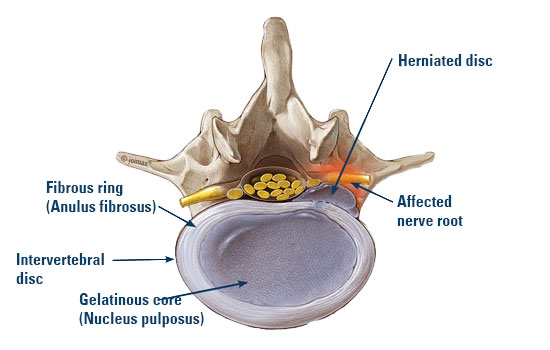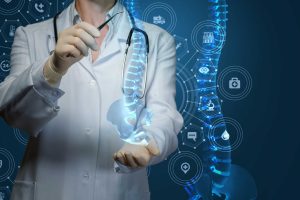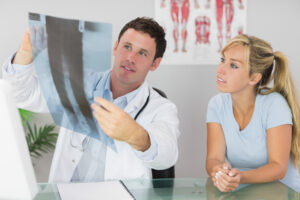Herniated Disc
The intervertebral discs are located between the vertebral bodies. They consist of a gelatinous, elastic core (nucleus), which is held in shape by a surrounding fiber ring (annulus). Normal aging processes or overloading can cause cracks in the fiber ring. Consequently, parts of the nucleus pulposus can be pushed through the annulus into the spinal canal.
What Causes a Herniated Disc?
A sudden rotational movement of the trunk or heavy lifting can cause a herniated disc. It can also be the result of poor posture in daily life (e.g. incorrect sitting or permanent and long-lasting driving), lack of exercise or dehydration. If there is not enough liquid available for the body, also the disc will dry out – and it will lose its elasticity.
Other risk factors for a herniated disc are obesity, pregnancy, or a general weakness of connective tissue. Age is another factor, as the intervertebral discs lose more and more fluid over the years.


What are the symptoms of a herniated disc?
Not all disc herniations cause pain. However, if tissue from the disc nucleus presses on the surrounding nerves, this will lead to severe, radiating pain, dysesthesia or even paralysis. Most commonly, discs in the lumbar spine are affected. In addition to back pain, they cause characteristic pain in the buttocks, legs and sometimes in the feet. These symptoms are popularly referred to as “sciatica”. Generally, the symptoms of a herniated disc appear in areas that are supplied by the affected nerve root.

Stop the pain in time
Anyone who suffers from chronic pain (e.g. permanent back pain) should urgently seek medical help. An MRI or CT scan can clarify whether the pain and symptoms are caused by a compressed nerve.
Surgical intervention should be considered when the pain does not improve after conservative treatment with intensive physical therapy, heat and pain medications or if paralysis occurs. In severe cases, symptoms such as neurological deficits or even organic functional problems like bladder and bowel problems can occur. A spinal surgeon should then be consulted urgently.

Contact and Clinic Finder
Do you need to find a clinic using
the joimax® methods?
Feel free to contact us!
Herniated Disc Treatment
Discover our innovative
minimally invasive treatment for herniated discs.
Contact and Clinic Finder
Do you need to find a clinic using the joimax® methods?
Feel free to contact us!
Herniated Disc Treatment
Discover our innovative
minimally invasive treatment for herniated discs.


